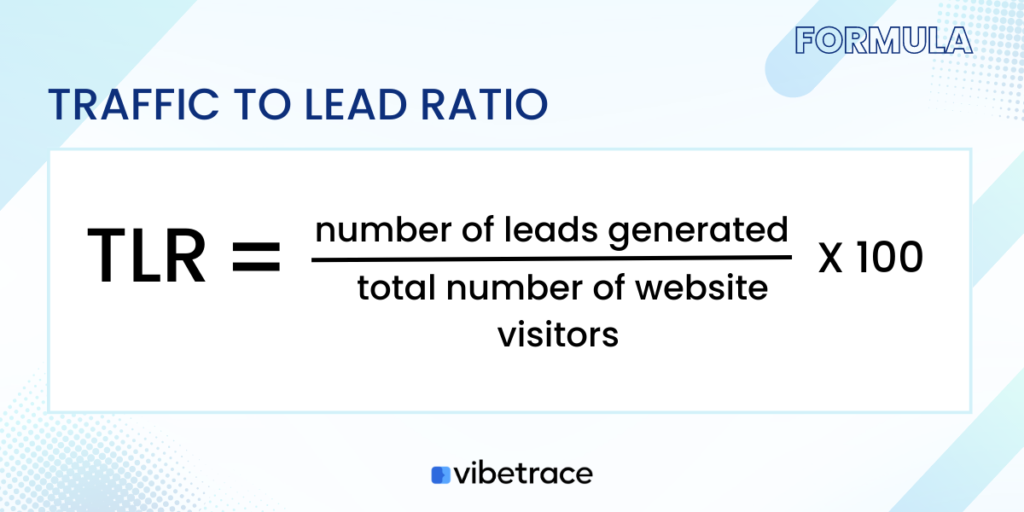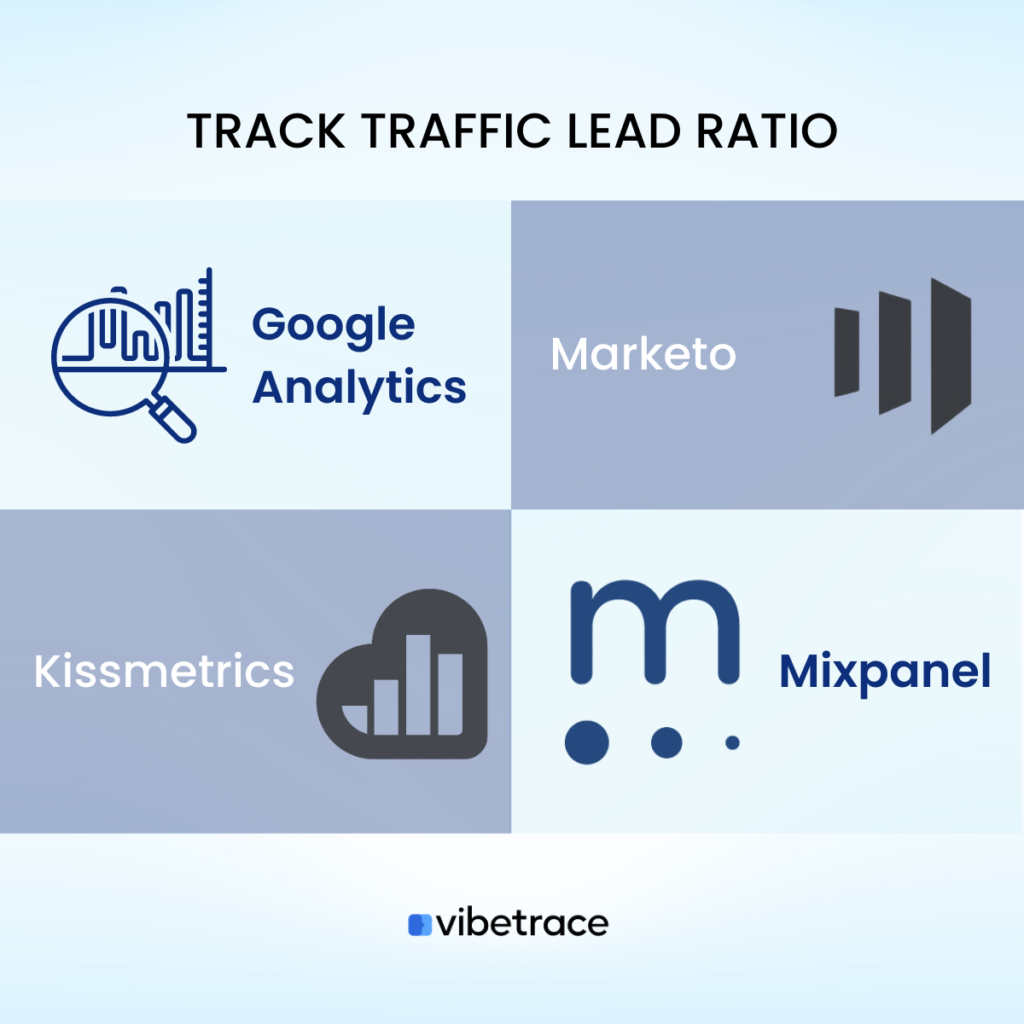The traffic to lead ratio also known as Lead Conversion Rate is a key metric that indicates the number of qualified leads your business generates from the traffic on its website.
Although websites can be a valuable tool for your business to increase value through organic traffic, it’s important to note that high traffic alone does not guarantee profitability.
To determine the quality of website traffic and increase the chances of converting visitors into leads, you should track your traffic to lead ratio and use this metric to adjust your strategies accordingly.
A lead is any visitor that gives you their contact information: email, phone number. Learn how to collect more leads from your website or you can use our services to grow subscribers list.
Additionally, you can gain insights into the effectiveness of their lead-generation efforts and identify areas for improvement. This can ultimately help them increase their chances of generating more leads and driving revenue.
What is Traffic to Lead Ratio?
Definition of Traffic to Lead Ratio
Traffic to lead ratio is a metric used in digital marketing to measure the effectiveness of a website or a specific marketing campaign in generating leads.
This metric refers to the percentage of visitors on a website who become leads once they start filling out a form, subscribing to a newsletter, or taking some other desired action based on the CTA.
Moreover, the traffic to lead ratio can help you understand the effectiveness of your marketing efforts from various channels in generating leads.
In analysis, a high traffic to lead ratio could mean that the website or marketing campaign you created is successfully converting visitors into leads, while a low ratio indicates that improvements are needed in the website or marketing strategy to increase lead generation.
Traffic to Lead Ratio Formula

The traffic to lead ratio is calculated by dividing the number of leads generated by the total number of website visitors during a specific period of time and multiplying the result by 100 to get a percentage.
For example, if a website had 10,000 visitors in a month and generated 500 leads, the traffic to lead ratio would be 5% (500/10,000 x 100).
| Traffic (avg daily) | New leads | TLR |
| 450 | 5 | 1.1% |
| 1.900 | 85 | 4.4% |
| 10.000 | 98 | 0.98% |
| 4.500 | 45 | 1% |
How to track Traffic to Lead Ratio?
Tracking traffic to lead ratio is one important if you want to improve your current strategies whether it’s doing great or not to help you identify the next step you can do for your marketing.
There are several tools available that can be used to track traffic to lead ratio for a website or a specific marketing campaign.
Here are some popular tools:

Google Analytics: Google Analytics is a free web analytics tool that provides detailed information about website traffic and user behavior that allows you to track the number of website visitors and the number of leads generated from different marketing campaigns.
Marketo: Marketo is a marketing automation platform that provides tools to track website traffic and leads. It allows you to create landing pages, forms, and email campaigns and provides analytics to measure the performance of your marketing efforts.
Mixpanel: Mixpanel is an analytics platform that specializes in event tracking and user engagement. It allows you to track website traffic and user behavior and provides insights into how visitors convert into leads.
How often should you check Traffic to Lead Ratio?
The frequency of checking traffic to lead ratio depends on the specific goals and needs of your business. However, it is generally recommended to monitor this metric on a regular basis to track the effectiveness of marketing efforts and make data-driven decisions.
Weekly or Bi-weekly: If your business has ongoing marketing campaigns or regular website updates, it may be necessary to check the traffic to lead ratio more frequently, such as weekly or bi-weekly, to identify trends and adjust you strategies accordingly.
Monthly or Quarterly: If your business has less frequent marketing efforts or less frequent website updates, it may be sufficient to check the traffic to lead ratio on a monthly or quarterly basis to track overall performance and make adjustments as needed.
It’s also important to keep in mind that traffic to lead ratio is just one metric that you as a business owner should track to measure the success of your marketing efforts.
Traffic to Lead Ratio Calculator
Do you want to calculate your traffic to lead ratio? Use our simple calculator below.
Simple Traffic to Lead Ratio Calculator
Number of leads:
Number of Visitors:
Traffic to Leads Rate
= ?
Important Things about Traffic to Lead Ratio
Here are some important things to keep in mind about the traffic to lead ratio:
High ratio indicates effective marketing efforts: A high traffic to lead ratio shows that your business lead generation efforts are effective, as seen by a high number of leads generated from its website or landing page. A low ratio, on the other hand, shows that your business lead generation efforts need to be improved in order to convert more visitors into leads.
Industry benchmarks as a Guide: The traffic to lead ratio varies across different industries and businesses as mentioned previously. Therefore, it is important to compare your businesss ratio with the industry benchmarks to determine whether your improvements and efforts are performing well or not.
Want to be up to date with Marketing?
Subscribe to our Retail CX newsletter!

Stay connected with what’s really important to optimize your digital revenues.
By clicking the button, you accept our Terms & Conditions. Also you will need to confirm your email address.
Importance of Conversion rate optimization (CRO): CRO is the process of improving a website or landing page in order to boost conversions. A high traffic-to-lead ratio is frequently the consequence of efficient CRO, which includes optimizing the layout, copy, and design of the website to encourage visitors to act and become leads.
Traffic sources are not the same: The traffic to lead ratio can vary depending on the source of traffic. For example, traffic from organic search results may have a higher conversion rate than traffic from social media. Therefore, it is important to measure the traffic to lead ratio for each traffic source to determine which sources are most effective.
Continuous improvement: The traffic to lead ratio is not a one-time metric. It should be monitored and analyzed regularly to identify trends and opportunities for improvement. By continuously improving the lead generation process, you can increase the traffic to lead ratio of your business and generate more leads from your website or landing page.
Metrics related to Traffic to Lead Ratio
There are several metrics related to the traffic to lead ratio that you should track and analyze to improve your lead generation efforts. These metrics include:
Customer Lifetime Value
The estimated total value of a customer to a business over the course of their lifetime
Customer Acquisition Cost
The cost of acquiring a new customer, including marketing and sales expenses.
List Growth Rate
Time on Site
The amount of time visitors spends on your website.
Vibetrace is here to help you with your needs!
This platform offers a range of email templates to help you target your subscriber list effectively. Whether you want to send welcome emails, cart abandonment emails, or promotional emails, Vibetrace has got you covered.
By incorporating Vibetrace on your website, you can easily keep track of your website visitors and connect with them through email marketing. It’s a great way to boost your marketing efforts and stay in touch with your audience. So why not give Vibetrace a try today?

